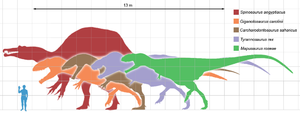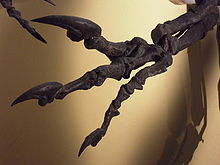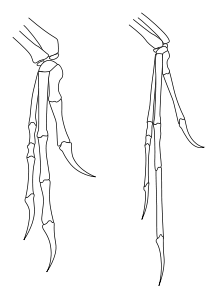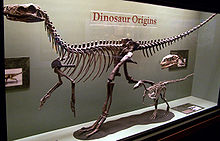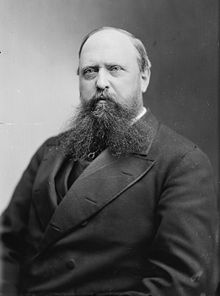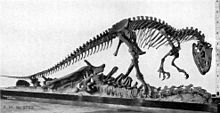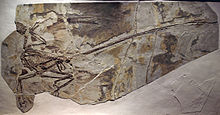- Theropoda
-
Theropods
Temporal range:
Late Triassic–present, 228–0 Ma
Mounted replica of a Tyrannosaurus rex skeleton Scientific classification 
Kingdom: Animalia Phylum: Chordata Class: Reptilia Superorder: Dinosauria Order: Saurischia Node: Eusaurischia Suborder: Theropoda
Marsh, 1881Subgroups - †Daemonosaurus
- †Eodromaeus
- †Eoraptor?
- †Herrerasauridae?
- †Tawa
- Neotheropoda
Theropoda (theropod /ˈθɛrəpɒd/; suborder name Theropoda /θɨˈrɒpɵdə/, from Greek meaning "beast feet") is both a suborder of bipedal saurischian dinosaurs, and a clade consisting of that suborder and its descendants (including modern birds). Dinosaurs belonging to the suborder theropoda were primarily carnivorous, although a number of theropod groups evolved herbivory, omnivory, and insectivory. Theropods first appeared during the Carnian age of the late Triassic period about 230 million years ago (Ma) and included the sole large terrestrial carnivores from the Early Jurassic until at least the close of the Cretaceous, about 65 Ma. In the Jurassic, birds evolved from small specialized coelurosaurian theropods, and are today represented by 9,900 living species.
Among the features linking theropod dinosaurs to birds are the three-toed foot, a furcula (wishbone), air-filled bones and (in some cases) feathers and brooding of the eggs.
Contents
Paleobiology
Diet
While historically generalized as exclusively carnivorous dinosaurs, theropods in fact displayed a wide range of diets.[1] All early finds of theropod fossils showed them to be primarily carnivorous. Theropod specimens known to scientists in the 19th and early 20th centuries all showed sharp teeth with serrated edges for cutting flesh, and some specimens even showed direct evidence of predatory behavior. For example, a Compsognathus fossil was found with a lizard in its stomach, and a Velociraptor specimen was found locked in combat with a Protoceratops (a type of ornithischian dinosaur).
The first confirmed non-carnivorous theropods found were the therizinosaurs, originally known as segnosaurs. First thought to be prosauropods, these enigmatic dinosaurs were later proven to be highly specialized, herbivorous theropods. Therizinosaurs possessed large abdomens for processing plant food, and small heads with beaks and leaf-shaped teeth. Further study of maniraptoran theropods and their relationships showed that therizinosaurs were not the only member of this group to abandon carnivory. Several other lineages of maniraptors show adaptations for an omnivorous diet, including seed-eating (some troodontids) and insect-eating (many avialans and alvarezsaurs). Oviraptorosaurs, ornithomimosaurs and advanced troodontids were likely omnivorous as well, and some theropods (such as Masiakasaurus and the spinosaurids) appear to have specialized in catching fish.[2][3]
Skin, scales and feathers
Mesozoic theropods were also very diverse in terms of skin texture and covering. Though feather-like structures are known in the related ornithischian dinosaurs,[4] evidence of feathers or feather-like structures has not been reported for any theropods less advanced than the coelurosaurs. More primitive theropods show evidence that their skin was covered in small, bumpy scales. In some species, these were interspersed with larger scales with bony cores, or osteoderms. This type of skin is best known in the ceratosaur Carnotaurus, which has been preserved with extensive skin impressions.[5]
The most primitive known protofeathered theropods are the compsognathids and early tyrannosauroids, both coelurosaurs. These early forms had feathers which were relatively short and composed of simple, possibly branching filaments.[6] Simple filaments are also seen in therizinosaurs, which also possessed large, stiffened "quill"-like feathers.
Most feathered theropods, including modern birds, usually retain scales only on the feet. Some forms seem to have mixed feathers elsewhere on the body as well. Scansoriopteryx preserved scales on the underside of the tail,[7] and Juravenator may have been predominantly scaly with some simple filaments interspersed.[8] On the other hand, some theropods were completely covered with feathers, such as the troodontid Anchiornis, which even had feathers on the feet and toes.[9]
Size
Tyrannosaurus was the largest and most popular theropod known to the general public for many decades. Since its discovery, however, a number of other giant carnivorous dinosaurs have been described, including Spinosaurus, Carcharodontosaurus, and Giganotosaurus.[10] The original Spinosaurus specimens (as well as newer fossils described in 2006) support the idea that Spinosaurus is larger than Tyrannosaurus, showing that Spinosaurus was possibly 6 meters longer and at least 1 metric ton heavier than Tyrannosaurus.[11] There is still no clear explanation for exactly why these animals grew so much larger than the predators that came before and after them.
The smallest non-avialan theropod known from adult specimens is the troodontid Anchiornis huxleyi, at 110 grams in weight and 34 centimeters (1 ft) in length.[9] When modern birds are included, the Bee Hummingbird Mellisuga helenae is smallest at 1.9 g and 5.5 cm (2.2 in) long.[12]
Nervous system and senses
Although rare, complete casts of theropod endocrania are known from fossils. Theropod endocrania can also be reconstructed from preserved brain cases without damaging valuable specimens by using a computed tomography scan and 3D reconstruction software. These finds are of evolutionary significance because they help document the emergence of the neurology of modern birds from that of earlier reptiles. An increase in the proportion of the brain occupied by the cerebrum seems to have occurred with the advent of the Coelurosauria and "continued throughout the evolution of maniraptorans and early birds."[13]
Forelimb morphology
Shortened forelimbs in relation to hind legs was a common trait among theropods, most notably in the abelisaurids (such as Carnotaurus) and the tyrannosaurids (such as Tyrannosaurus). This trait was, however, not universal: spinosaurids had well developed forelimbs, so also did many coelurosaurs. One genus, Xuanhanosaurus, has also been claimed to have been quadrupedal because of its comparatively robust forelimbs, but this is no longer thought to be likely.[14]
The hands are also very different among the different groups. the most common is an appendage consisting of 3 fingers, the digits I, II and III (or possibly II, III and IV)[15] with sharp claws. Some basal theropods (Herrerasaurus, Eoraptor) had 4 digits, and also a reduced metacarpal V. Ceratosaurians usually had 4 digits, while most tetanurans had 3.[16]
The forelimbs' scope of use is also believed to have also been different among different families. The spinosaurids could have used their powerful forelimbs to hold fishes. Some small coelurosaurus (dromaeosaurids, scansoriopterygids) are believed to have used their forelimbs to climb in trees, and birds, which are believed to be descendants of theropods, use them for flight.
Forelimb movement
Contrary to the way theropods have often been reconstructed in art and the popular media, the range of motion of theropod forelimbs was severely limited, especially compared with the forelimb dexterity of humans and other primates.[17] Most notably, theropods and other bipedal saurischian dinosaurs (including the bipedal prosauropods) could not pronate their hands—that is, they could not rotate the forearm so that the palms faced the ground or backwards towards the legs. In humans, pronation is achieved by motion of the radius relative to the ulna (the two bones of the forearm). In saurischian dinosaurs, however, the end of the radius near the elbow was actually locked into a groove of the ulna, preventing any movement. Movement at the wrist was also limited in many species, forcing the entire forearm and hand to move as a single unit with little flexibility.[18] In theropods and prosauropods, the only way for the palm to face the ground would have been by lateral splaying of the entire forelimb, as in a bird raising its wing.[17]
In carnosaurs like Acrocanthosaurus, the hand itself retained a relatively high degree of flexibility, with mobile fingers. This was also true of more basal theropods such as herrerasaurs and dilophosaurs. Coelurosaurs showed a shift in the use of the forearm, with greater flexibility at the shoulder allowing the arm to be raised towards the horizontal plane, and to even greater degrees in flying birds. However, in coelurosaurs such as ornithomimosaurs and especially dromaeosaurs, the hand itself had lost most flexibility, with highly inflexible fingers. Dromaeosaurs and other maniraptorans also showed increased mobility at the wrist not seen in other theropods, thanks to the presence of a specialized half-moon shaped wrist bone (the semi-lunate carpal) that allowed the whole hand to fold backward towards the forearm in the manner of modern birds.[18]
Paleopathology
In 2001, Ralph E. Molnar published a survey of pathologies in theropod dinosaur bone. He found pathological features in 21 genera from 10 families. Pathologies were found in theropods of all body size although they were less common in fossils of small theropods, although this may be an artifact of preservation. They are very widely represented throughout the different parts of theropod anatomy. The most common sites of preserved injury and disease in theropod dinosaur in the ribs and tail vertebrae. Despite being abundant in ribs and vertebrae, injuries seem to be "absent... or very rare" on the bodies' primary weight supporting bones like the sacrum, femur, and tibia. The lack of preserved injuries in these bones suggests that they were selected by evolution for resistance to breakage. The least common sites of preserved injury are the cranium and forelimb, with injuries occurring in about equal frequency at each site. Most pathologies preserved in theropod fossils are the remains of injuries like fractures, pits, and punctures, often likely originating with bites. Some theropod paleopathologies seem to be evidence of infections, which tended to be confined only to small regions of the animal's body. Evidence for congenital malformities have also been found in theropod remains. Such discoveries can provide information useful for understanding the evolutionary history of the processes of biological development. Unusual fusions in cranial elements or asymmetries in the same are probably evidence that one is examining the fossils of an extremely old individual rather than a diseased one.[19]
Evolutionary history
During the late Triassic, a number of primitive proto-theropod and theropod dinosaurs existed and evolved alongside each other.
The earliest and most primitive of the theropod dinosaurs were the carnivorous Eodromaeus and the herrerasaurids of Argentina (as well as, possibly, the omnivorous Eoraptor). The herrerasaurs existed during the early late Triassic (Late Carnian to Early Norian). They were found in North America and South America and possibly also India and Southern Africa. The herrerasaurs were characterised by a mosaic of primitive and advanced features. Some paleontologists have in the past considered the herrerasaurians to be members of Theropoda, while other theorized the group to be basal saurischians, and may even have evolved prior to the saurischian-ornithischian split. Cladistic analysis following the discovery of Tawa, another Triassic dinosaur, suggests the herrerasaurs likely were early theropods.[20]
The earliest and most primitive unambiguous theropods (or alternatively, "Eutheropoda" – 'True Theropods') are the Coelophysoidea. The Coelophysoidea were a group of widely distributed, lightly built and potentially gregarious animals. They included small hunters like Coelophysis and (possibly) larger predators like Dilophosaurus. These successful animals continued from the Late Carnian (early Late Triassic) through to the Toarcian (late Early Jurassic). Although in the early cladistic classifications they were included under the Ceratosauria and considered a side-branch of more advanced theropods,[21] they may have been ancestral to all other theropods (which would make them a paraphyletic group).[22][23]
The somewhat more advanced ceratosaurs (including Ceratosaurus and Carnotaurus) appeared during the Early Jurassic and continued through to the Late Jurassic in Laurasia. They competed alongside their more anatomically advanced tetanuran relatives and—in the form of the abelisaur lineage—lasted to the end of the Cretaceous in Gondwana.
The Tetanurae are more specialised again than the ceratosaurs. They are subdivided into the basal Megalosauroidea (alternately Spinosauroidea) and the more derived Avetheropoda. Megalosauridae were primarily Middle Jurassic to Early Cretaceous predators, and their spinosaurid relatives' remains are mostly from Early and Middle Cretaceous rocks. Avetheropoda, as their name indicates, were more closely related to birds and are again divided into the Allosauroidea (the diverse carcharodontosaurs) and the Coelurosauria (a very large and diverse dinosaur group including the birds).
Thus, during the late Jurassic, there were no fewer than four distinct lineages of theropods—ceratosaurs, megalosaurs, allosaurs, and coelurosaurs—preying on the abundance of small and large herbivorous dinosaurs. All four groups survived into the Cretaceous, and three of those—the ceratosaurs, coelurosaurs, and allosaurs—survived to end of the period, where they were geographically separate, the ceratosaurs and allosaurs in Gondwana, and the coelurosaurs in Laurasia.
Of all the theropod groups, the coelurosaurs were by far the most diverse. Some coelurosaur groups that flourished during the Cretaceous were the tyrannosaurids (including Tyrannosaurus) the dromaeosaurids (including Velociraptor and Deinonychus, which are remarkably similar in form to the oldest known bird, Archaeopteryx[24][25]), the bird-like troodontids and oviraptorosaurs, the ornithomimosaurs (or "ostrich dinosaurs"), the strange giant-clawed herbivorous therizinosaurs, and the avialans, which include modern birds and is the only dinosaur lineage to survive the Cretaceous-Paleogene extinction event.[26] While the roots of these various groups are found in the Middle Jurassic, they only became abundant during the Early Cretaceous. A few paleontologists, such as Gregory S. Paul, have suggested that some or all of these advanced theropods were actually descended from flying dinosaurs or proto-birds like Archaeopteryx that lost the ability to fly and returned to a terrestrial habitat.[27]
Classification
History of classification
The name Theropoda (meaning "beast feet") was first coined by O.C. Marsh in 1881.[28] Marsh initially named Theropoda as a suborder to include the family Allosauridae, but later expanded its scope, re-ranking it as an order to include a wide array of "carnivorous" dinosaur families, including Megalosauridae, Compsognathidae, Ornithomimidae, Plateosauridae and Anchisauridae (now known to be herbivorous prosauropods) and Hallopodidae (now known to be relatives of crocodilians). Due to the scope of Marsh's Order Theropoda, it came to replace a previous taxonomic group that Marsh's rival E.D. Cope had created in 1866 for the carnivorous dinosaurs, Goniopoda ("angled feet").[14]
By the early 20th century, some paleontologists, such as Friedrich von Huene, no longer considered carnivorous dinosaurs to have formed a natural group. Huene abandoned the name Theropoda, instead using Harry Seeley's Order Saurischia, which Huene divided into the suborders Coelurosauria and Pachypodosauria. Huene placed most of the small theropod groups into Coelurosauria, and the large theropods and prosauropods into Pachypodosauria, which he considered ancestral to the Sauropoda (prosauropods were still thought of as carnivorous at this time, owing to the incorrect association of rauisuchian skulls and teeth with prosauropod bodies, in animals such as Teratosaurus).[14] In W.D. Matthew and Barnum Brown's 1922 description of the first known dromaeosaurid (Dromaeosaurus albertensis[29]), they became the first paleontologists to exclude prosauropods from the carnivorous dinosaurs, and attempted to revive the name Goniopoda for that group, though neither of these suggestions were accepted by other scientists.[14]
It was not until 1956 that Theropoda came back into use as a taxon containing the carnivorous dinosaurs and their descendants, when Alfred Romer re-classified the Order Saurischia into two suborders, Theropoda and Sauropoda. This basic division has survived into modern paleontology, with the exception of, again, the Prosauropoda, which Romer included as an infraorder of theropods. Romer also maintained a division between Coelurosauria and Carnosauria (which he also ranked as infraorders). This dichotomy was upset by the discovery of Deinonychus and Deinocheirus in 1969, neither of which could be classified easily as "carnosaurs" or "coelurosaurs." In light of these and other discoveries, by the late 1970s Rinchen Barsbold created a new series of theropod infraorders: Coelurosauria, Deinonychosauria, Oviraptorosauria, Carnosauria, Ornithomimosauria, and Deinocheirosauria.[14]
With the advent of cladistics and phylogenetic nomenclature in the 1980s, and their development in the 1990s and 2000s, a clearer picture of theropod relationships began to emerge. Several major theropod groups were named by Jacques Gauthier in 1986, including the clade Tetanurae for one branch of a basic theropod split with another group, the Ceratosauria. As more information about the link between dinosaurs and birds came to light, the more bird-like theropods were grouped in the clade Maniraptora (also named by Gauthier in 1986). These new developments also came with a recognition among most scientists that birds arose directly from maniraptoran theropods and, with the abandonment of ranks in cladistic classification, the re-evaluation of birds as a subset of theropod dinosaurs that happened to have survived the Mesozoic extinctions into the present.[14]
Major groups
Theropods are a highly diverse group, and many major Mesozoic lineages have been identified:
- †Herrerasaurids, probably early theropods, though they may be more primitive saurischians or even non-dinosaurs
- †Coelophysoids, primitive theropods including Coelophysis
- †Dilophosaurids, crested theropods sometimes allied with the coelophysoids
- †Ceratosaurians, including Ceratosaurus and abelisaurids. The latter were important Late Cretaceous predators in southern continents
- Tetanurans, a major grouping of more advanced theropods
- †Megalosauroids, including the crocodile-skulled spinosaurids
- Avetheropods, more advanced and bird-like theropods
- †Allosauroids, including Allosaurus and close relatives like the carcharodontosaurids
- Coelurosaurians, a diverse lineage with a wide range of body sizes, diets and niches
- †Tyrannosauroids, small to gigantic carnivores, often with reduced forelimbs
- †Ornithomimosaurians, "ostrich-mimics", mostly toothless and probably omnivorous
- Maniraptorans, birds and their closest relatives, all possessed feathers, many omnivorous or herbivorous
- †Therizinosaurs, bipedal herbivores with large hand claws and small heads
- †Alvarezsaurs, small bird-like insectivores with extremely short forelimbs
- †Oviraptorosaurians, mostly toothless; their diet and lifestyle are uncertain
- †Deinonychosaurs, popularly known as "raptors", extremely bird-like omnivores with some pure carnivores
- Avialans, the group including modern birds (the only living dinosaurs) and other winged theropods
- †Scansoriopterygids, small insectivorous theropods that may have lived in trees
- Avians, traditional birds
Relationships
The following cladogram is adapted from Weishampel et al., 2004.[30] It retains Coelophysoidea as possible ceratosaurs, as opposed to many recent studies placing them outside ceratosaurs and ancestral to both ceratosaurs and tetanurae.
Theropoda unnamed †Ceratosauria †Neoceratosauria †Abelisauroidea
Tetanurae Avetheropoda †Carnosauria Coelurosauria Tyrannoraptora Maniraptoriformes Maniraptora †Therizinosauroidea
Paraves Birds
See also
- Bird
- Sauropod
- Ornithopod
- Marginocephalian
- Thyreophoran
References
- ^ Zanno, L.E., Gillette, D.D., Albright, L.B., and Titus, A.L. (2009). "A new North American therizinosaurid and the role of herbivory in 'predatory' dinosaur evolution." Proceedings of the Royal Society B, Published online before print July 15, 2009, doi: 10.1098/rspb.2009.1029.
- ^ Longrich, Nicholas R.; and Currie, Philip J. (2009). "Albertonykus borealis, a new alvarezsaur (Dinosauria: Theropoda) from the Early Maastrichtian of Alberta, Canada: Implications for the systematics and ecology of the Alvarezsauridae". Cretaceous Research 30 (1): 239–252. doi:10.1016/j.cretres.2008.07.005.
- ^ Holtz, T.R.; Jr; Brinkman, D.L.; Chandler, C.L. (1998). "Dental morphometrics and a possibly omnivorous feeding habit for the theropod dinosaur Troodon". GAIA 15: 159–166.
- ^ Zheng, Xiao-Ting; You, Hai-Lu; Xu, Xing; Dong, Zhi-Ming (19 March 2009). "An Early Cretaceous heterodontosaurid dinosaur with filamentous integumentary structures". Nature 458 (7236): 333–336. doi:10.1038/nature07856. PMID 19295609.
- ^ Bonaparte, Novas, and Coria (1990). "Carnotaurus sastrei Bonaparte, the horned, lightly built carnosaur from the Middle Cretaceous of Patagonia." Contributions in Science (Natural History Museum of Los Angeles County), 416: 41 pp.
- ^ Göhlich, U.B.; Chiappe, L.M. (2006). "A new carnivorous dinosaur from the Late Jurassic Solnhofen archipelago". Nature 440 (7082): 329–332. doi:10.1038/nature04579. PMID 16541071.
- ^ Czerkas, S.A., and Yuan, C. (2002). "An arboreal maniraptoran from northeast China." Pp. 63–95 in Czerkas, S.J. (Ed.), Feathered Dinosaurs and the Origin of Flight. The Dinosaur Museum Journal 1. The Dinosaur Museum, Blanding, U.S.A. PDF abridged version
- ^ Goehlich, U.B.; Tischlinger, H.; Chiappe, L.M. (2006). "Juraventaor starki (Reptilia, Theropoda) ein nuer Raubdinosaurier aus dem Oberjura der Suedlichen Frankenalb (Sueddeutschland): Skelettanatomie und Wiechteilbefunde". Archaeopteryx 24: 1–26.
- ^ a b Xu, X.; Zhao, Q.; Norell, M.; Sullivan, C.; Hone, D.; Erickson, G.; Wang, X.; Han, F. et al. (2009). "A new feathered maniraptoran dinosaur fossil that fills a morphological gap in avian origin". Chinese Science Bulletin 54 (3): 430–435. doi:10.1007/s11434-009-0009-6. Abstract
- ^ Therrien, F.; and Henderson, D.M. (2007). "My theropod is bigger than yours...or not: estimating body size from skull length in theropods". Journal of Vertebrate Paleontology 27 (1): 108–115. doi:10.1671/0272-4634(2007)27[108:MTIBTY]2.0.CO;2.
- ^ dal Sasso, C.; Maganuco, S.; Buffetaut, E.; and Mendez, M.A. (2005). "New information on the skull of the enigmatic theropod Spinosaurus, with remarks on its sizes and affinities". Journal of Vertebrate Paleontology 25 (4): 888–896. doi:10.1671/0272-4634(2005)025[0888:NIOTSO]2.0.CO;2. http://www.bioone.org/perlserv/?request=get-abstract&doi=10.1671%2F0272-4634%282005%29025%5B0888%3ANIOTSO%5D2.0.CO%3B2.
- ^ Conservation International (Content Partner); Mark McGinley (Topic Editor). 2008. "Biological diversity in the Caribbean Islands." In: Encyclopedia of Earth. Eds. Cutler J. Cleveland (Washington, D.C.: Environmental Information Coalition, National Council for Science and the Environment). [First published in the Encyclopedia of Earth May 3, 2007; Last revised August 22, 2008; Retrieved November 9, 2009]. <http://www.eoearth.org/article/Biological_diversity_in_the_Caribbean_Islands>
- ^ "Abstract", in Chure (2001). Pg. 19.
- ^ a b c d e f Rauhut, O.W. (2003). The Interrelationships and Evolution of Basal Theropod Dinosaurs. Blackwell Publishing, 213 pp. ISBN 0-901702-79-X
- ^ See Origin of birds/Digit homology.
- ^ Some genera within Avetheropoda however, had 4 digits, see University of Maryland department of geology home page, "Theropoda I" on Avetheropoda, 14 july 2006.
- ^ a b Carpenter, K. (2002). "Forelimb biomechanics of nonavian theropod dinosaurs in predation". Senckenbergiana lethaea 82 (1): 59–76. doi:10.1007/BF03043773.
- ^ a b Senter, P.; Robins, J.H. (2005). "Range of motion in the forelimb of the theropod dinosaur Acrocanthosaurus atokensis, and implications for predatory behaviour". Journal of Zoology, London 266 (3): 307–318. doi:10.1017/S0952836905006989.
- ^ Molnar, R. E., 2001, Theropod paleopathology: a literature survey: In: Mesozoic Vertebrate Life, edited by Tanke, D. H., and Carpenter, K., Indiana University Press, p. 337-363.
- ^ Nesbitt, S. J.; Smith, N. D.; Irmis, R. B.; Turner, A. H.; Downs, A. & Norell, M. A. (2009). "A complete skeleton of a Late Triassic saurischian and the early evolution of dinosaurs". Science 326 (5959): 1530–1533. doi:10.1126/science.1180350. PMID 20007898.
- ^ Rowe, T., and Gauthier, J., (1990). "Ceratosauria." Pp. 151–168 in Weishampel, D. B., Dodson, P., and Osmólska, H. (eds.), The Dinosauria, University of California Press, Berkley, Los Angeles, Oxford.
- ^ Mortimer, M. (2001). "Rauhut's Thesis", Dinosaur Mailing List Archives, 4 Jul 2001.
- ^ Carrano, M. T.; Sampson, S. D.; Forster, C. A. (2002). "The osteology of Masiakasaurus knopfleri, a small abelisauroid (Dinosauria: Theropoda) from the Late Cretaceous of Madagascar". Journal of Vertebrate Paleontology 22 (3): 510–534. doi:10.1671/0272-4634(2002)022[0510:TOOMKA]2.0.CO;2.
- ^ Ostrom, J.H. (1969). "Osteology of Deinonychus antirrhopus, an unusual theropod from the Lower Cretaceous of Montana". Peabody Museum Natural History Bulletin 30: 1–165.
- ^ Paul, G.S. (1988). Predatory Dinosaurs of the World. New York: Simon and Schuster Co. (ISBN 0-671-61946-2)
- ^ Dingus, L. and Rowe, T. (1998). The Mistaken Extinction: Dinosaur Evolution and the Origin of Birds. Freeman.
- ^ Paul, G.S. (2002). Dinosaurs of the Air: The Evolution and Loss of Flight in Dinosaurs and Birds. Baltimore: Johns Hopkins University Press. 472 pp. (ISBN 0-8018-6763-0)
- ^ Marsh, O.C. (1881). "Principal characters of American Jurassic dinosaurs. Part V." The American Journal of Science and Arts, series 3 21: 417–423.
- ^ Matthew, W. D.; Brown, B. (1922). "The family Deinodontidae, with notice of a new genus from the Cretaceous of Alberta". Bulletin of the American Museum of Natural History 46: 367–385.
- ^ Weishampel, D.B., Dodson, P., and Osmólska, H. (eds.) (2004). The Dinosauria, Second Edition. Berkeley: University of California Press, 861 pp.
Categories:- Theropods
Wikimedia Foundation. 2010.


